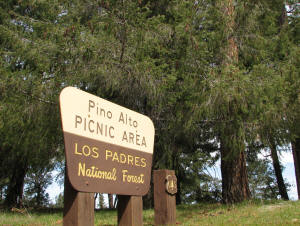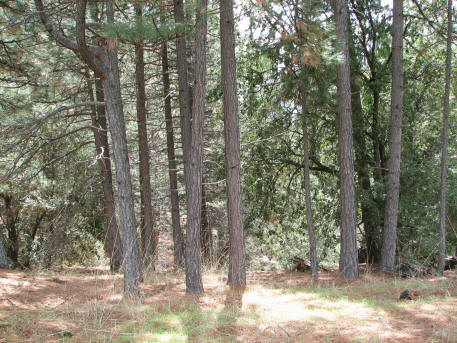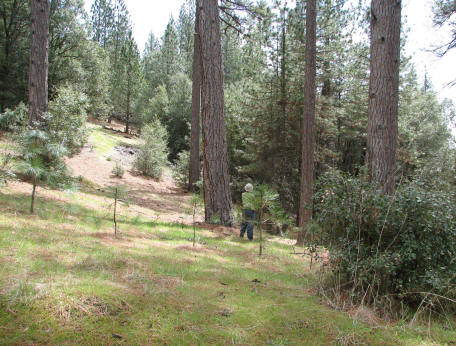|
November 6, 2006
FOREST
THINNING PROJECT APPROVED FOR FIGUEROA MOUNTAIN RECREATION AREA
Officials Agree to Impose Strict Environmental
Protections
Across Most of Project Area
The U.S. Forest Service has agreed to
dramatically scale back its thinning proposal for the Figueroa
Mountain Recreation Area in the Los Padres National Forest. The
decision comes after dozens of local residents and two
conservation groups – Santa Barbara-based Los Padres ForestWatch
and Tucson-based Center for Biological Diversity – expressed
concerns about the fate of Figueroa Mountain’s majestic old
growth forests and wildlife.

Figueroa Mountain is one of the most
popular forest recreation areas in Santa Barbara County. Rising
to an elevation of 4,528 feet above the scenic wine country of
the Santa Ynez Valley, it’s a place of ancient big cone Douglas
firs and ponderosa pines. The Figueroa Mountain Recreation Area
contains miles of trails, mountain streams, a campground, and a
nature trail surrounding a picnic area. Winter brings an
occasional dusting of snow, while the springtime heralds
dazzling wildflower displays of golden poppies and blue lupines.
 All
this was threatened after officials announced their logging plan
for Figueroa Mountain in 2004. Under the Figueroa Mountain
Project, the U.S. Forest Service would conduct selective
logging, removing some trees while leaving others standing.
Officials would also use a masticator – a dozer with a giant
lawnmower attachment – to grind up oaks, manzanitas, and
low-lying shrubs. The project was proposed under the Bush
Administration’s ill-named “Healthy Forests Initiative,” which
fast-tracked logging on our national forests at the expense of
public participation and environmental review. All
this was threatened after officials announced their logging plan
for Figueroa Mountain in 2004. Under the Figueroa Mountain
Project, the U.S. Forest Service would conduct selective
logging, removing some trees while leaving others standing.
Officials would also use a masticator – a dozer with a giant
lawnmower attachment – to grind up oaks, manzanitas, and
low-lying shrubs. The project was proposed under the Bush
Administration’s ill-named “Healthy Forests Initiative,” which
fast-tracked logging on our national forests at the expense of
public participation and environmental review.
Unlike the HFI, however, the Figueroa
Mountain Project was actually based on good intentions.
Decades of fire suppression had caused the timber stands on
Figueroa to become overgrown, and officials feared that if a
wildfire hit the area, it would burn too intensely for any trees
to survive. In the long term, thinning would eventually allow
controlled burns to take place on Figueroa, restoring fire as a
critical component of this forest ecosystem.

Decades of fire
suppression have caused forests on Figueroa Mountain to become
too dense, leaving them susceptible to high-intensity wildfires.
First Victory – Public Disclosure of
Information
In November 2004, the Forest Service
released a short description of the project and opened up a
thirty-day public comment period. But faced with less than a
single page of project details, the public didn’t really have
much to comment on. ForestWatch wrote a letter to the agency,
asking for additional details and requesting documents under the
Freedom of Information Act. In response, officials released a
six-page project description and agreed to another 30-day
comment period.
The new information was shocking. Trees as
large as thirty inches in diameter would be cut – trees so big
that it would take two people holding hands to wrap their arms
around them. Even trees “of all ages and sizes” were targeted
in certain areas. In all, 80% of the trees on Figueroa Mountain
would be cut – hardly something that would promote a healthy
forest.
Second Victory – Preparation of Environmental Assessment
ForestWatch also learned that the agency
would conduct the logging without first preparing an
Environmental Assessment. Instead, officials announced their
intent to exploit a loophole called a “categorical exclusion,”
severely curtailing the public’s right to suggest improvements
for the project.
In a letter to the agency, ForestWatch
notified officials that this project did not qualify for the
loophole, and that the agency would need to prepare an
Environmental Assessment before allowing any logging.
ForestWatch also provided evidence showing that if the agency
cut down larger trees, it would increase – not decrease – the
fire danger in the area. Larger trees have built up a strong
fire resistance over their lifespan, and when they’re removed,
dry flammable brush grows in their place.
In response to the ForestWatch letter,
officials agreed to prepare a full Environmental Assessment for
this project. The Forest Service complained that this step
would just be a waste of money, but the assessment was critical
to study ways to improve the agency's original proposal.
Third Victory – Forest Health Alternative
At the same time, ForestWatch provided the
agency with an alternative plan that would truly restore forest
health while protecting the large trees on Figueroa Mountain.
This scientifically-based plan included a prohibition on
removing trees more than 12-16 inches in diameter – half the
size of the Forest Service’s original proposal. It emphasized
thinning by hand, instead of using heavy machinery like the
masticator that could damage the fragile forest floor. Our
alternative plan would achieve all of the agency’s forest health
goals without all the incidental – yet serious – damage caused
by an intensive clearing and thinning operation.
This spring, ForestWatch celebrated yet
another victory by convincing the agency to include our Forest
Health Alternative as Alternative 3 in the Environmental
Assessment. During the public comment period, 78 concerned
citizens – including environmentalists, former firefighters,
nearby cabin owners, and others – wrote letters to the agency,
asking officials to adopt this superior alternative.
Fourth Victory – A Precedent-Setting Decision
In September, after reviewing all the
public comments, the Forest Service issued its final decision on
the Figueroa Mountain Project. The agency heard our community’s
call for strong forest protections, imposing a strict 12”
diameter limit across most of the project area. Officials also
adopted strong protections, like requiring vehicles to stay on
roadways, retaining large snags for wildlife, restricting the
masticator to one-tenth of the project area, conducting surveys
of California spotted owls, and imposing buffers up to 330 feet
from mountain streams.
What began as a plan to cut trees “of all
ages and sizes” without any public disclosure or environmental
review, now has strict diameter limits and other protective
measures and an Environmental Assessment. The Forest Service
didn't address all of our concerns, but the agency made enough
improvements to convince us not to appeal the project at this
time. ForestWatch commends local Forest Service officials for
their willingness to make needed improvements to this project.

Larger conifers like these will be spared from
the chainsaw.
The decision to adopt strict diameter
limits has implications far beyond Figueroa Mountain, and sets a
precedent for five other forest thinning proposals in the Los
Padres National Forest. These projects cover more than 7,300
acres of forestland on popular mountaintops like Mt. Pinos,
Frazier Mountain, and Pine Mountain in Ventura County.
ForestWatch will continue to demand strong
protections for our local forests, and will monitor the Forest
Service’s implementation of the Figueroa Mountain Project next
spring. For now, though, we can all rest assured that the large
trees that stand sentry on Figueroa Mountain will remain,
towering over forest visitors and providing valuable wildlife
habitat for generations to come.
|